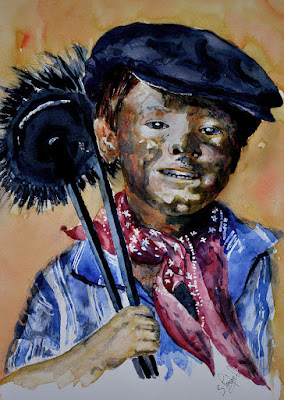Blake’s Chimney Sweeper Poems
The poem “The
Chimney Sweeper” is set against the dark background of child labour, a
crude horror of the Industrial Revolution that was well known in England in the
late 18th century. The poems (Chimney Sweeper in Innocence and
Experience) are meant to convey two different views of human life, the view of
innocence and the view of experience. Here we see the naturalistic world of
childhood against the world of corruption. Blake writes these poems to let the
reader knows that many kid’s lives are being exploited in the cities of
England. He expresses his disgust about the plight of the majority of the
chimney sweepers and how the society and church turn a blind eye of their sufferings.
In the society they live in, innocent children are in anguish because of the
harsh treatment of the adult population.
The “first poem” highlights the life of
Tom Dacre, a chimney sweeper who is born to a world of abject poverty. His mother is dead. His
father sold him as a chimney sweeper, making him little more than a slave. Yet
this boy still manages the type of optimism. Here is an immense contrast
between the death, weeping, exploitations and oppression that Tom Dacre endures
and his childlike innocence that enables him to be native about his grave
situation and the widespread injustice in society. Tom Dacre’s imagination
takes him on a lovely journey with his ultimate hope of being nurtured and
cared for by his Father in Heaven. Despite the
sadness of this poem a hint of hope still lingers. The same cannot be said of “The
Chimney Sweeper” in Songs
of Experience.
The boy was abandoned by his hypocritical parents to die as a chimney sweeper
while they go to church to pray.
👉The Lamb William
Blake Analysis, Summary, Theme, Symbolism
👉William Blake's The
Tyger Poem Summary, Analysis, Line by Line Analysis
👉William Blake Poem
London Analysis, Summary, Title, London as a Poem against Social Injustices
👉Blake's Mysticism and Symbolism in The Lamb
👉A Comparative Study
on Blake’s two Chimney Sweeper Poems
The
symbolism and pictorial beauty is textured by the warp and woof. Tom’s hair is
described as “curl’d like a lamb’s back”. A lamb is a common symbol of
innocence and is one that Blake uses often in Songs of
Innocence. While comforting Tom, the narrator says now “the
soot cannot spoil your white hair”. The narrator is saying that the
horridness of their situation cannot taint Tom’s purity and innocence as a
child. However, by having his head shaved, Tom’s innocence is symbolically
forcibly stolen. “Coffins of black” symbolizes their death in the chimney.
Through their deaths, the boys actually regain their innocence because they
become “naked & white,” which are symbols of purity and innocence.
A line that rings of experience is “They clothed me in the clothes of death”. This
child is acknowledging that he is going to die soon.
The poem ends with the sentiment, “If all do their duty, they need
not fear harm”. Even though they both are living terrible
existences, there is still hope in death. They want an Angel to come save them
and bring them to green pastures where everything will be perfect. His faith in God
is so strong that it becomes his only constant source of hope and inspiration.
The optimistic outlook, which is real to Tom, is revealed to be unrealistic on
earth.
William Blake’s two Chimney
Sweeper poems from the Songs of Innocence
and Songs of Experience
show a progression in the awareness of a young chimney-sweeper, from an
innocent child clouded by childhood euphoria to a mature one whose awareness of
his own life reveals a stark contrast between the privileged and the
downtrodden. The first provides a lingering sense of hope. Tom and his
friends can look forward to being at peace in heaven even though the hope of
death is disturbing. The second does no such thing. Instead, it depicts a child
whose innocence was stolen and replaced with experience.
~~~~~*~~~~~












0 Comments
Post a Comment